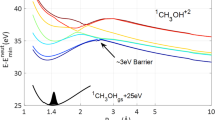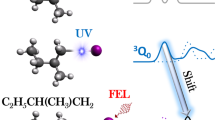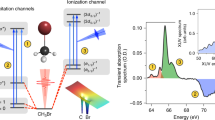Abstract
For the past several decades, we have been able to directly probe the motion of atoms that is associated with chemical transformations and which occurs on the femtosecond (10−15-s) timescale. However, studying the inner workings of atoms and molecules on the electronic timescale1,2,3,4 has become possible only with the recent development of isolated attosecond (10−18-s) laser pulses5. Such pulses have been used to investigate atomic photoexcitation and photoionization6,7 and electron dynamics in solids8, and in molecules could help explore the prompt charge redistribution and localization that accompany photoexcitation processes. In recent work, the dissociative ionization of H2 and D2 was monitored on femtosecond timescales9 and controlled using few-cycle near-infrared laser pulses10. Here we report a molecular attosecond pump–probe experiment based on that work: H2 and D2 are dissociatively ionized by a sequence comprising an isolated attosecond ultraviolet pulse and an intense few-cycle infrared pulse, and a localization of the electronic charge distribution within the molecule is measured that depends—with attosecond time resolution—on the delay between the pump and probe pulses. The localization occurs by means of two mechanisms, where the infrared laser influences the photoionization or the dissociation of the molecular ion. In the first case, charge localization arises from quantum mechanical interference involving autoionizing states and the laser-altered wavefunction of the departing electron. In the second case, charge localization arises owing to laser-driven population transfer between different electronic states of the molecular ion. These results establish attosecond pump–probe strategies as a powerful tool for investigating the complex molecular dynamics that result from the coupling between electronic and nuclear motions beyond the usual Born–Oppenheimer approximation.
This is a preview of subscription content, access via your institution
Access options
Subscribe to this journal
Receive 51 print issues and online access
$199.00 per year
only $3.90 per issue
Buy this article
- Purchase on Springer Link
- Instant access to full article PDF
Prices may be subject to local taxes which are calculated during checkout



Similar content being viewed by others

References
Corkum, P. B. & Krausz, F. Attosecond science. Nature Phys. 3, 381–387 (2007)
Kapteyn, H., Cohen, O., Christov, I. & Murnane, M. Harnessing attosecond science in the quest for coherent X-rays. Science 317, 775–778 (2007)
Kling, M. F. & Vrakking, M. J. J. Attosecond electron dynamics. Annu. Rev. Phys. Chem. 59, 463–492 (2008)
Krausz, F. & Ivanov, M. Attosecond physics. Rev. Mod. Phys. 81, 163–234 (2009)
Hentschel, M. et al. Attosecond metrology. Nature 414, 509–513 (2001)
Drescher, M. et al. Time-resolved atomic inner-shell spectroscopy. Nature 419, 803–807 (2002)
Uiberacker, M. et al. Attosecond real-time observation of electron tunnelling in atoms. Nature 446, 627–632 (2007)
Cavalieri, A. L. et al. Attosecond spectroscopy in condensed matter. Nature 449, 1029–1032 (2007)
Kelkensberg, F. et al. Molecular dissociative ionization and wave-packet dynamics studied using two-color XUV and IR pump-probe spectroscopy. Phys. Rev. Lett. 103, 123005 (2009)
Kling, M. F. et al. Control of electron localization in molecular dissociation. Science 312, 246–248 (2006)
Remacle, F. & Levine, R. D. An electronic time scale in chemistry. Proc. Natl Acad. Sci. USA 103, 6793–6798 (2006)
Kuleff, A. I. & Cederbaum, L. S. Charge migration in different conformers of glycine: the role of nuclear geometry. Chem. Phys. 338, 320–328 (2007)
Wickenhauser, M., Burgdorfer, J., Krausz, F. & Drescher, M. Time resolved Fano resonances. Phys. Rev. Lett. 94, 023002 (2005)
Sanz-Vicario, J. L., Bachau, H. & Martin, F. Time-dependent theoretical description of molecular autoionization produced by femtosecond XUV laser pulses. Phys. Rev. A 73, 033410 (2006)
Kienberger, R. et al. Atomic transient recorder. Nature 427, 817–821 (2004)
Uphues, T. et al. Ion-charge-state chronoscopy of cascaded atomic Auger decay. New J. Phys. 10, 025009 (2008)
Remetter, T. et al. Attosecond electron wave packet interferometry. Nature Phys. 2, 323–326 (2006)
Mauritsson, J. et al. Attosecond pump-probe electron interferometry. Phys. Rev. Lett (submitted)
Bucksbaum, P. H., Zavriyev, A., Muller, H. G. & Schumacher, D. W. Softening of the H2 + molecular bond in intense laser fields. Phys. Rev. Lett. 64, 1883–1886 (1990)
Frasinski, L. J. et al. Manipulation of bond hardening in H2 + by chirping of intense femtosecond laser pulses. Phys. Rev. Lett. 83, 3625–3628 (1999)
Sansone, G. et al. Isolated single-cycle attosecond pulses. Science 314, 443–446 (2006)
Eppink, A. T. J. B. & Parker, D. H. Velocity map imaging of ions and electrons using electrostatic lenses: application in photoelectron and photofragment ion imaging of molecular oxygen. Rev. Sci. Instrum. 68, 3477–3484 (1997)
Ito, K., Hall, R. I. & Ukai, M. Dissociative photoionization of H2 and D2 in the energy region of 25–45 eV. J. Chem. Phys. 104, 8449–8457 (1996)
Sanchez, I. & Martin, F. Origin of unidentified structures in resonant dissociative photoionization of H2 . Phys. Rev. Lett. 79, 1654–1657 (1997)
Sanchez, I. & Martin, F. Resonant dissociative photoionization of H2 and D2 . Phys. Rev. A 57, 1006–1017 (1998)
Rudenko, A. et al. Real-time observation of vibrational revival in the fastest molecular system. Chem. Phys. 329, 193–202 (2006)
Martin, F. et al. Single photon-induced symmetry breaking of H2 dissociation. Science 315, 629–633 (2007)
Dietrich, P., Ivanov, M. Y., Ilkov, F. A. & Corkum, P. B. Two-electron dissociative ionization of H2 and D2 in infrared laser fields. Phys. Rev. Lett. 77, 4150–4153 (1996)
Sola, I. J. et al. Controlling attosecond electron dynamics by phase-stabilized polarization gating. Nature Phys. 2, 319–322 (2006)
Ghafur, O., Siu, W., Kling, M., Drescher, M. & Vrakking, M. J. J. A velocity map imaging detector with an integrated gas injection system. Rev. Sci. Instrum. 80, 033110 (2009)
Acknowledgements
This work is part of the research programs of the Stichting voor Fundamenteel Onderzoek der Materie, which is financially supported by the Nederlandse Organisatie voor Wetenschappelijk Onderzoek, and of the Spanish Ministerio de Ciencia e Innovación, project no. FIS2007-60064. We acknowledge support from MC-RTN XTRA (FP6-505138), the MC-EST MAXLAS, Laserlab Europe (Integrated Infrastructure Initiative Contract RII3-CT-2003-506350, proposal cusbo001275), the European COST Action CUSPFEL (CM0702), the Mare Nostrum Barcelona Supercomputer Center, the Centro de Computación Científica UAM, the Netherlands National Computing Facilities foundation, Stichting Academisch Rekencentrum Amsterdam, Programme Alβan for Latin America (E07D401391CO), the Universidad de Antioquia, the COLCIENCIAS agency, the Swedish Research Council, the Deutsche Forschungsgemeinschaft via the Emmy Noether Programme and the Cluster of Excellence: Munich Centre for Advanced Photonics.
Author information
Authors and Affiliations
Contributions
G.S. was responsible for the construction of the attosecond pump–probe set-up and the experiments on H2 and D2. F.K. was responsible for the experiments on H2 and D2 and the development of the semi-classical model. M.Yu.I. helped with the semi-classical model. J.F.P.-T. and F. Morales were responsible for the construction of the close-coupling code and the calculations using this code. M.F.K., W.S., O.G., P.J., M.S., E.B., F.F., F.L., S.Z. and I.Z. contributed to the experiments, which were carried out in three prolonged experimental sessions over almost 18 months. M.N. was in charge of the laboratory where the experiments were performed. A.L’H. supervised M.S. and P.J. F. Martin supervised F. Morales and J.F.P.-T. and was in charge of work with the TDSE model. J.L.S.-V. helped with the TDSE model. M.J.J.V. supervised F.K., W.S., O.G. and P.J. and was responsible for the overall coordination of the project
Corresponding author
Ethics declarations
Competing interests
The authors declare no competing financial interests.
Supplementary information
Supplementary Figures
This file contains Supplementary Figure 1 with legend. (PDF 39 kb)
Rights and permissions
About this article
Cite this article
Sansone, G., Kelkensberg, F., Pérez-Torres, J. et al. Electron localization following attosecond molecular photoionization. Nature 465, 763–766 (2010). https://doi.org/10.1038/nature09084
Received:
Accepted:
Issue Date:
DOI: https://doi.org/10.1038/nature09084
This article is cited by
-
Ultrafast quantum control of atomic excited states via interferometric two-photon Rabi oscillations
Communications Physics (2024)
-
Light as fast as electrons
Nature Physics (2023)
-
Open questions in attochemistry
Communications Chemistry (2023)
-
Probing electron localization during molecular dissociation by femtosecond strong-field ion momentum spectroscopy
Communications Physics (2023)
-
Attosecond electron motion control in dielectric
Nature Photonics (2022)
Comments
By submitting a comment you agree to abide by our Terms and Community Guidelines. If you find something abusive or that does not comply with our terms or guidelines please flag it as inappropriate.


